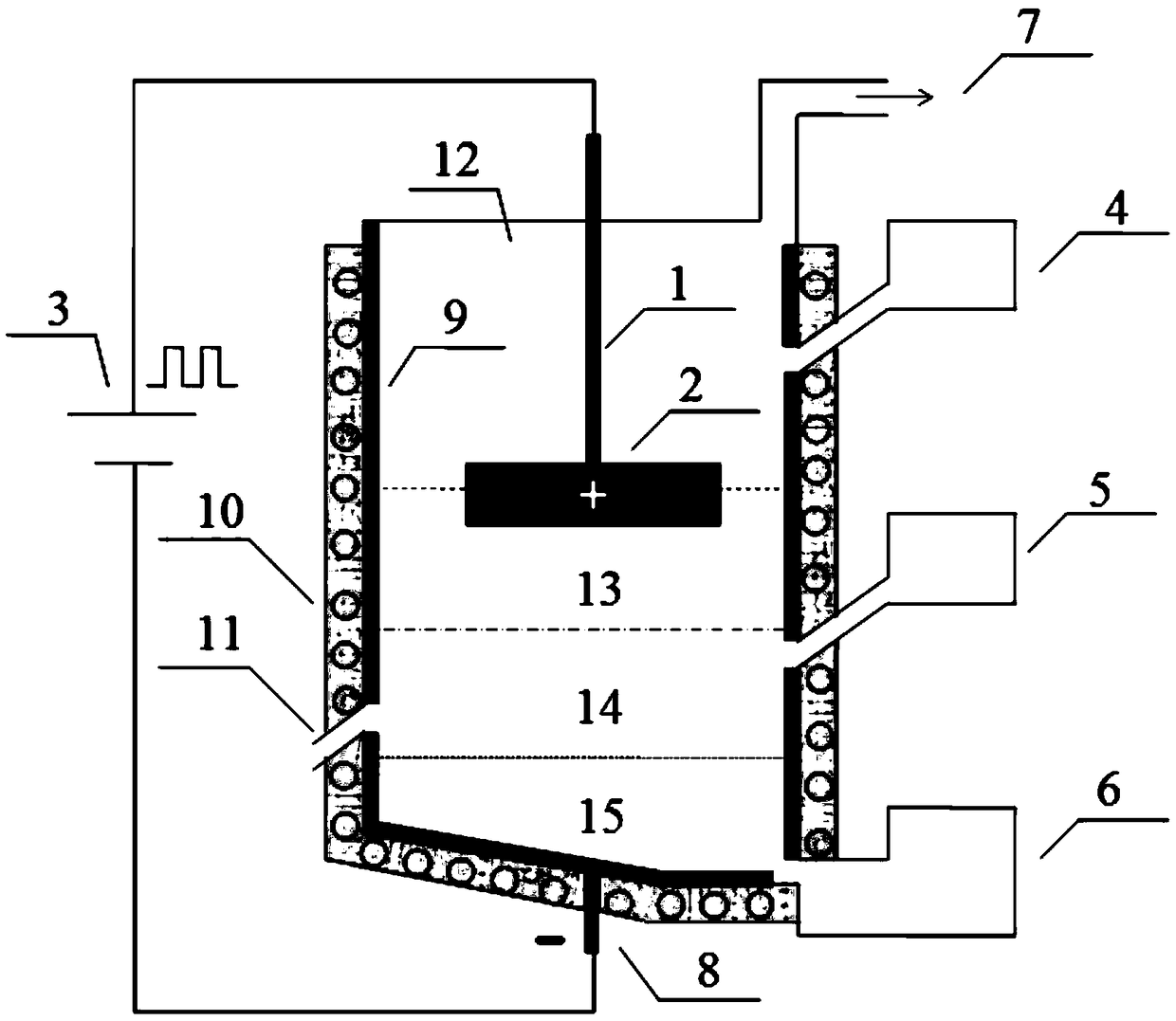A low-temperature molten salt electrolytic clean metallurgy method and device for antimony
A low-temperature molten salt and electrolysis device technology, applied in the direction of electrolysis components, electrolysis process, electrodes, etc., can solve the problems of complex equipment and high energy consumption, and achieve the effects of short process, low energy consumption and pollution reduction
- Summary
- Abstract
- Description
- Claims
- Application Information
AI Technical Summary
Problems solved by technology
Method used
Image
Examples
Embodiment 1
[0027] The chemical composition of antimony concentrate A is (%): Sb 54.7, Fe 2.8, S 15.7, As 0.35, Pb 0.22, SiO 2 11.4, Au 87.5g / t. Weigh 100g antimony concentrate A and 20g Na respectively 2 S, 79.1g NaCl and 100.9g KCl. First add 20g Na 2 S, 79.1g NaCl and 100.9g KCl are mixed uniformly. After that, 80 g of the mixed molten salt and 100 g of antimony concentrate A were taken out and mixed uniformly. The mixed material is spread flat on the bottom of the furnace of the low-temperature molten salt electrolysis device through the antimony-containing material feed port, and then the remaining 120 g of the mixed molten salt is spread on the upper layer of the mixture through the inert molten salt feed port. Adjust the height of the anode guide rod so that the graphite anode is inserted into the inert molten salt on the upper layer, and the anode and cathode pole distance is 4cm. Turn on the power of the external resistance heating layer and heat up to 880°C. Turn on the pulse ...
Embodiment 2
[0029] The chemical composition of antimony concentrate B is (%): Sb 32.6, Fe 16.9, S 32.4, As 1.3, SiO 2 13.7, Pb0.17, Au 77.5g / t. Weigh 200g antimony concentrate B and 100g K respectively 2 S, 175.8g NaCl and 224.2g KCl. First put 100g K 2 S, 175.8g NaCl and 224.2g KCl are mixed uniformly. Then, 160 g of the antimony concentrate B was taken out from the mixed molten salt and mixed with 200 g of antimony concentrate B. The mixed material is spread flat on the bottom of the furnace of the low-temperature molten salt electrolysis device through the antimony-containing material feed port, and then the remaining 240 g of mixed molten salt is spread through the inert molten salt feed port on the upper layer of the mixture. Adjust the height of the anode guide rod so that the graphite anode is inserted into the inert molten salt on the upper layer, and the anode and cathode pole distance is 8cm. Turn on the power of the external resistance heating layer and heat up to 920°C. Tur...
Embodiment 3
[0031] The chemical composition of antimony concentrate C is (%): Sb 78.2, As 2.6, Fe 1.6, Pb 0.3. Weigh 100g antimony concentrate C and 15g Na respectively 2 S, 48.3g NaCl and 61.7g KCl. First add 15g Na 2 S, 48.3g NaCl and 61.7g KCl are mixed uniformly. Afterwards, 50 g of the antimony concentrate C is taken out from the uniformly mixed molten salt and mixed with 100 g of antimony concentrate C. The mixed material is spread flat on the bottom of the furnace of the low-temperature molten salt electrolysis device through the antimony-containing material feed port, and then the remaining 75 g of the mixed molten salt is spread flat on the upper layer of the mixture through the inert molten salt feed port. Adjust the height of the anode guide rod so that the graphite anode is inserted into the upper layer of inert molten salt, and the anode and cathode pole distance is 6cm. Turn on the power of the external resistance heating layer and heat up to 850°C. Turn on the pulse power...
PUM
 Login to View More
Login to View More Abstract
Description
Claims
Application Information
 Login to View More
Login to View More - R&D
- Intellectual Property
- Life Sciences
- Materials
- Tech Scout
- Unparalleled Data Quality
- Higher Quality Content
- 60% Fewer Hallucinations
Browse by: Latest US Patents, China's latest patents, Technical Efficacy Thesaurus, Application Domain, Technology Topic, Popular Technical Reports.
© 2025 PatSnap. All rights reserved.Legal|Privacy policy|Modern Slavery Act Transparency Statement|Sitemap|About US| Contact US: help@patsnap.com

